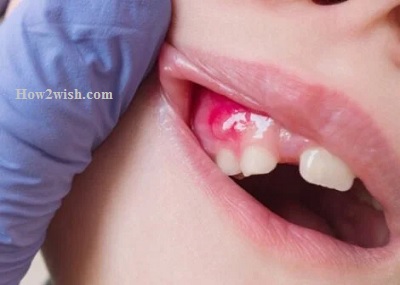What to do when you see Fistula on the gums? “A fistula appeared on the gum, what should I do?” There are quite a lot of such questions on the Internet. Often people drag out a trip to the doctor until the last minute or wait for the pain to subside. But this does not solve the problem, soon harmful microorganisms are already spreading throughout the oral cavity, and the scale of the disaster is increasing.

We suggest that you understand the features of the disease and find out what measures are being taken to correct the situation. But in any case, you cannot do without the help of a dentist, so it is better to gather your courage and still visit the clinic.
Fistula on the gum in the tooth: what is it and how does it look
When soft jaw tissues are inflamed for a long time, microorganisms begin to multiply in them and purulent fluid (exudate) accumulates. When it becomes too much, an exit hole appears, which is called a perforating channel. Such pathology is defined as a fistula, which looks like a red bump or pimple with a white dot in the middle or on the side. Its diameter can reach 1 centimeter. You can hear its other name – fistula, which in Latin means “tube”. He usually appears next to the patient.
Why are fistulas formed on the gums?
There are many situations in which microbes can begin to multiply. Let’s take a look at some of them.
caries and pulpitis
How soon do you go to the dentist when you notice dark spots? Many delay it to the last until they get tired of enduring the pain. But it is much easier and more comfortable to remove the affected area until it has spread to the pulp – the neurovascular bundle that nourishes and protects the jaw from the penetration of harmful microorganisms.
If you do not start to solve the problem when the first symptoms appear, then the nerve may die, and the bacteria will quickly spread to neighboring teeth.
Periodontitis
After the infection penetrates from the pulp chamber into the root and further, into the apex, the spread of pus begins, affecting the tissues. At this time, it is under pressure, so it can easily form a fistulous tube. This process is called periodontitis. Usually, a fistula occurs only after prolonged inflammation.
What causes a fistula on the gum: cysts or granulomas
When periodontitis takes a chronic granulomatous form, a cyst grows – a small sac covered with epithelium and filled with purulent fluid. Its diameter can vary from one to six centimeters, and the granulomas themselves do not reach five millimeters. Cystogranuloma does not allow exudate into other tissues, but if it is close to the surface, then a fistulous canal appears over time.
perforated root
When a dentist cleans the space inside a tooth, he can sometimes make the mistake of pressing hard on the file, the needle that processes the root course. Or it is wrong to direct it, because of which a hole (perforation) is formed, which always leads to an inflammatory process. When the doctor notices that he is mistaken, he must immediately close the channel. But not everyone does this, and subsequently, the tooth has to be removed, since it is no longer treatable.
In modern clinics, after treatment procedures, a final X-ray is performed to ensure the effectiveness of the work done. The doctor must not only show, but also decipher them to the patient. If he does not, feel free to ask yourself.
Periostitis
Almost everyone has met with this disease, even though many hear this name for the first time. In people, inflammation of the periosteum is commonly called a flux. When it appears, a person feels severe pain, swelling of the gums and facial tissues, and fever. Most often, it ends with the appearance of a hole from which purulent deposits come out.
Periodontitis
A fistula can form not only as a result of complications of diseased teeth but also because of their poor-quality cleaning. The plaque that appears on the surface gradually hardens, transforming into a periodontal pocket. Microbes accumulate there, which further leads to inflammatory processes. The periodontal ligaments are destroyed and it becomes difficult for the pus to come out, so it creates a hole.
Complications from treatment
There are still unpleasant situations with poor-quality elimination of caries or pulpitis, in such cases, it continues to develop already under the filling. When removing any unit, certain difficulties may also arise, for example, if this is done with non-sterile devices, the infection easily penetrates through the affected area. Therefore, do not be lazy to read reviews about a specialist before going to him.

It is better to give preference to private clinics, they are equipped with modern equipment that helps the doctor fix the problem even in hard-to-reach areas.
These are the most common reasons why a fistula appears on the gum. But do not forget about other situations:
- with oncological diseases of the jaws, several fistulas with copious purulent discharge may form;
- inflammation is possible when wisdom teeth cannot erupt;
- if the crown does not fit snugly against the dent, bacteria can accumulate under it;
- with injuries, and damage to the gums, an infection can also penetrate.
Also, it is worth paying attention to some factors that provoke the appearance of the disease and complicate its course:
- non-compliance with oral hygiene;
- violations in occlusion (jaw closure) and malocclusion;
- exposure to too high or low temperatures, as well as their differences;
- stressful, neurotic state;
- overwork, chronic fatigue;
- weakening of the immune system;
- metabolic disorders, malnutrition, lack of essential substances;
- abuse of carbohydrates and foods high in sugar;
- smoking.
Fistula on the gum: symptoms
The signs of this pathology are very obvious, so it is quite easy to determine it:
- a reddish bump appears, from which a liquid flows out, unpleasant in taste, sometimes bloody;
- a person feels pain, which becomes stronger when brushing or chewing, and after the release of pus, it decreases;
- the tissue near the diseased tooth may swell, sometimes along with the cheek or lip;
- the mouth smells of rot, and the taste of food changes due to exudate;
- there is unreasonable weakness, apathy;
- the temperature rises;
- enlarged nearby lymph nodes.
Possible Complications
Many do not understand why a fistula on the gums is dangerous, therefore they do not use the services of a dentist, believing that the disease goes away along with the pain. This is completely wrong: despite the comfortable sensations, bacteria continue to multiply in the affected area, and this leads to unpleasant consequences that are life-threatening:
- loss of teeth;
- sinusitis, sepsis (blood poisoning);
- the appearance of cysts;
- suppuration in the brain;
- the formation of polyps and ulcers on the heart valves;
- abscess of facial and cervical tissue;
- jaw destruction.
If you bring the condition to such pathologies, then the treatment will be long and painful.
How and how is a fistula on the gums treated: conservative methods
They are used only when there are no complications, and the diseased tooth can still be saved. In the process, the abscess is cleared, inflammation is removed and damage is restored. Three methods are most often combined: endodontic, medical, and physiotherapy.
Endodontics
This type of therapy can be carried out in different ways, depending on why the fistula appeared and how the disease proceeds:
- First, you need to get to the pulp chamber by preparing the tooth cavity. It is possible to cut off dead tissue with a dental bur. If only caries are present, then only the affected enamel and dentin (bone substance) can be removed.
- With pulpitis, the chamber is opened and the nerve is removed. If necessary, sealers and fillers are removed from the “dead” tooth, with which the canals were sealed. In addition, you need to take pictures or use an apex locator to measure their exact length, since it is very important to reach the apical foramen. To facilitate the work, special softening preparations can be used.
- Next, the doctor must expand the channels for future filling and treat them with antiseptics or endodontic devices. They are then left open for several days and rinsed with antiseptic solutions. This helps to remove the purulent fluid through the roots.
- After that, a temporary filling is done with calcium hydroxide sealers for 1-3 months, which can be repeated up to three times.
- Then the holes are finally sealed using gutta-percha pins, a final x-ray is taken and the supragingival part is restored using fillings or crowns.
How to treat a fistula in the gums with antibiotics
Such drugs are prescribed to eliminate pathogenic microorganisms, which led to the onset of an inflammatory process. Since a solution or injection applied topically is not as effective, an antibiotic is needed. If the cause is a cold or hypothermia, you need to take Amoxicillin or Augmentin. In addition to them, it is possible to use Ciprofloxacin, Lincomycin, Tsiprolet, Ofloxacin, Flemoxab Solutab, and Sumamed. Sometimes it is supplemented with Metronidazole.

visit this post Gum Plastic Surgery Of The Anterior Teeth
Remember that only a doctor can prescribe medication. Do not self-medicate, but come to “Dentika”: the clinic’s specialists will select the right type of therapy, prescribe medications and relieve you of problems at the optimal time.
Ointments and gels
Experts believe that external treatment quickly removes pus, disinfects the wound, relieves pain, and heals the fistula itself. Ointments are not very effective in this matter, as they are immediately washed off with saliva. Antibacterial and anesthetic gels such as Holisal, Kalgel, Dentol, Dentinox, and others are more suitable for this work. Solcoseryl is prescribed as a healing agent.
Anti-inflammatory and painkillers
Sometimes the pain becomes unbearable when Fistula on the gums, the doctor may prescribe Ketonal, Ibuprofen, Nise, Arcoxia, Naproxen, Ketorol, Ketoprofen, and other drugs for internal or external use. Always read the instructions carefully before taking the pill.
Antihistamines
With the help of Claritin, Tavegil, and Suprastin, doctors eliminate allergic reactions and swelling and remove toxins. Do not abuse the reception of funds, it is better to consult a specialist and undergo a course of treatment.
Rinse aids
The dentist may advise rinsing the mouth with special solutions: chlorhexidine, uracil, Miramistin, Stomatofit, Chlorophyllipt, and Betadine. Folk remedies also remain effective: soda-salt solutions, and decoctions of chamomile, sage, and other herbs.
Physical Methods
To achieve a faster effect of treatment, dentists supplement it with physiotherapy:
- ultrasound or laser treatment;
- ultra phonophoresis;
- factorization;
- magnetotherapy;
- coagulation, etc.
Surgical techniques
Sometimes, with severe forms of development, you can get rid of the problem only through an operation:
- opening and drainage of the abscess;
- root resection, amputation, hemisection, corona-radicular separation, replantation, cystotomy, cystectomy;
- tooth extraction and others.
How and how can a fistula on the gums of a pregnant woman be cured
Some expectant mothers refuse to visit the dentist, fearing to harm the baby. Indeed, while the fetus is developing, it is better not to perform operations and not take medications, but inflammation and ulcers will be much more dangerous for the child if they are not cured.
Usually, only those methods of treatment are used that are allowed by obstetrician-gynecologists. Sometimes they only clean purulent formations, and the main methods of therapy are used only after childbirth. In any case, each situation must be considered on an individual basis with the attending physician.
Prevention for Fistula on the gums
The development of a fistula is not a pleasant situation, so it is better to make sure that it does not occur at all:
- brush your teeth regularly at least twice daily;
- if you notice carious formations, go to the doctor as soon as possible;
- visit the dentist at least twice a year, as it is not always possible to see any problems on your own;
- watch what you eat, reduce the consumption of sweets and spicy;
- drink less coffee and alcohol.
Compliance with these rules will save you not only from dental diseases but also from other health problems.
When a fistula appears on the gums in the tooth, its causes and treatment, as a rule, become interconnected. Therefore, before you start taking any measures, you need to find out why the pathology arose. And this can only be done by a qualified specialist using special equipment.
You should not self-medicate at home, it is better to immediately sign up for a doctor at Dentik. Then you can cope with the disease without pain and extra effort.